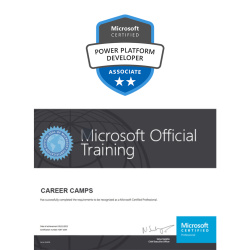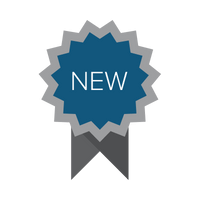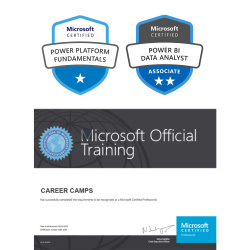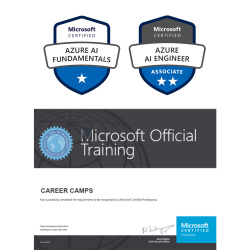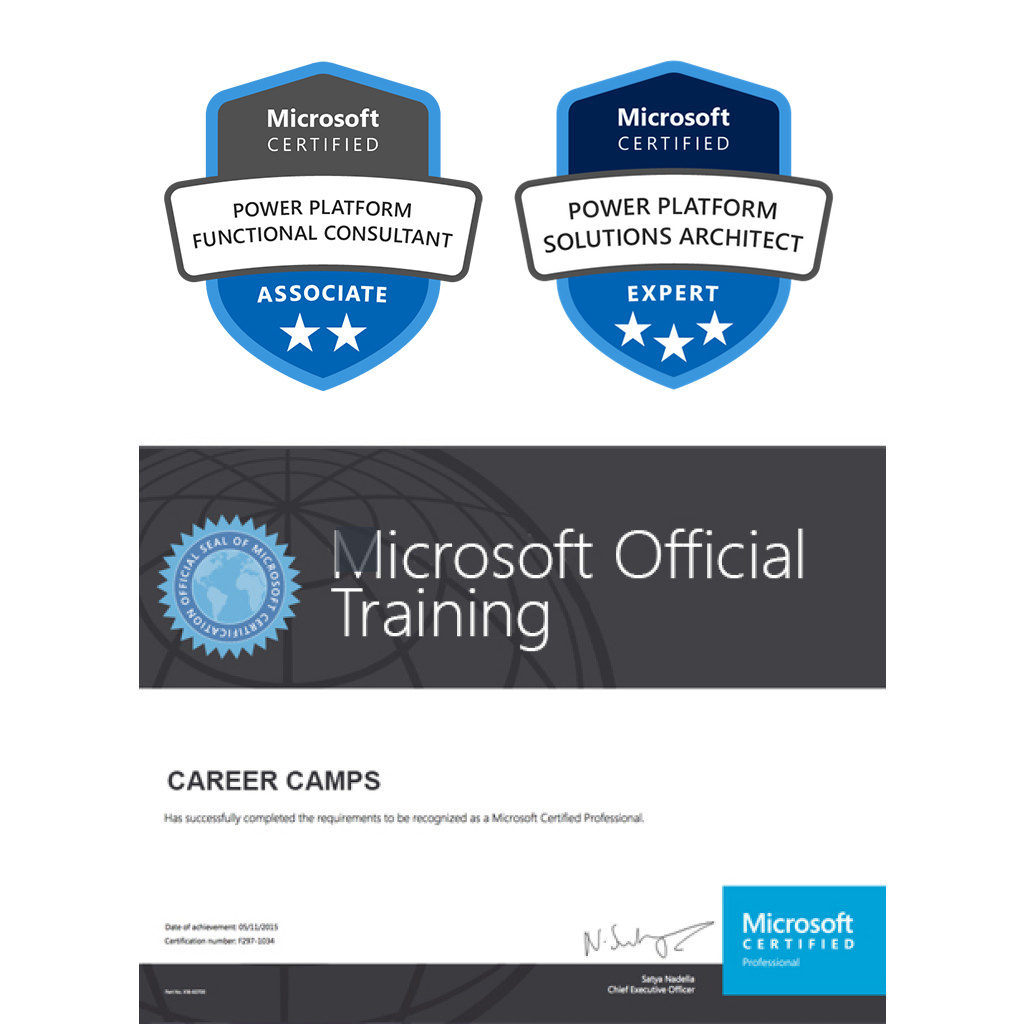
MCA Microsoft Power Platform Functional Consultant + MCE Microsoft Power Platform Solution Architect Certification Camp
$3,995.00
Participants in the Microsoft Official Power Platform Bootcamp complete two courses and two exams to earn the MCA Power Platform Functional Consultant and MCE Power Platform Solution Architect certifications. This hands-on, instructor-led live camp offers comprehensive, end-to-end technical training on the Microsoft Power Platform.
We also offer the MCA Microsoft Power Platform Developer Associate Certification Camp.
EXAMS INCLUDED
PL-200: Microsoft Power Platform Functional Consultant
PL-600: Microsoft Power Platform Solution Architect
WHAT IS INCLUDED
| Airfare to/from Sarasota, FL | |
| 6 Nights of Lodging | |
| Ground Transportation | |
| Microsoft Training Books | |
| 2 Microsoft Exam Vouchers | |
| 1 Retake Voucher (per exam, if needed) | |
| Onsite Pearson Vue Test Center | |
| Microsoft Study Labs & Simulations |
LOCATIONS
Career Camps primary Microsoft Training campus (for individual students) is located in Sarasota, FL. Can’t travel to our facility? No problem! You will save on airfare, lodging and transportation. Just contact us and we will get you pricing to attend the class online live virtually from your work or home. If you do not see the location or class you are looking for, let us know! We have access to hundreds of classes and locations all across the United States and also offer corporate and group rates. If you have 5 or more students we can even come to you! With several partnerships in place, we are sure to have something to fit your needs. Whether you need to get MCA or MCE Certified, or get updated on Microsoft Windows Server 2022, we’ve got you covered.
Description
The Microsoft Certified Power Platform Functional Consultant Associate and Microsoft Certified Power Platform Solution Architect Expert Boot Camp delivers comprehensive training and certification in an accelerated format. Designed for IT professionals and developers, this course teaches how to create no-code or low-code solutions using Power Apps, Power BI, and Power Virtual Agents.
During the boot camp, students will take two certification exams—PL-200 (Power Platform Functional Consultant) and PL-600 (Power Platform Solution Architect)—to earn both the MCA and MCE Power Platform certifications. This hands-on, instructor-led course emphasizes real-world application of Power Platform tools while fully preparing students for the certification exams, which are taken during the camp.
The Microsoft Certified Power Platform Functional Consultant Associate boot camp is taught using Microsoft Official Courseware –
PL-200T00: Microsoft Power Platform Functional Consultant
PL-600T00: Microsoft Power Platform Solution Architect
Skills Gained:
Work with an organization to gather requirements and implement Power Platform solutions
Build model-driven, canvas, and portal apps
Create Power Automate flows
Design a simple chatbot using Power Virtual Agents
Analyze data using Power BI visualizations and dashboards
Becoming a Solution Architect/Getting to know your customer
Conceptualizing the design from requirements
Project governance and working as a team
Microsoft Power Platform Architecture
Data Modeling
Analytics and artificial intelligence
Power Apps Architecture
Application Lifecycle Management
Power Automate Architecture
Security Modeling
Integration
Dynamics 365 Applications Architecture
Power Virtual Agents Architecture
Robotic Process Automation
Testing and Go Live
Topics Covered in this Official Boot Camp:
Introduction to Microsoft Power Platform
Microsoft Power Platform overview
Work with Dataverse
Work with tables
Understand data types and behavior
Configure security settings
Make model-driven apps with Power Apps
Building blocks of model-driven apps
Design model-driven apps
Forms and views
Make canvas apps with Power Apps
Power Apps studio
Canvas apps capabilities
User experience
Make portals with Power Apps
Power Apps portals architecture
Access Microsoft Dataverse in your portal
Authentication and user management
Introduction to automation
Business rules
Power Automate overview
Build Power Automate cloud flows
Fundamentals of cloud flows
Triggers
Actions
Build Power Automate desktop flows
Build desktop flows
Use desktop flows
Process advisor
Build business process flows
Why use business process flows
Using business process flow designer
Automating your business process flow
Build chatbots with Power Virtual Agents
Create a chatbot
Configure topics
Automate and integrate
Configure entities
Test and publish chatbots
Analyze data with Power BI
Use tabular reporting options in Dataverse
Use charts and dashboards in Dataverse
Get started with Power BI
Model data in Power BI
Create visualizations and dashboards
Publish and share in Power BI
Putting it all together
Using solutions
AI Builder
Consultant skills
Becoming a Solution Architect/Getting to know your customer
Lesson
Define a Solution Architect
Role of a Solution Architect on projects
Project Methodology
Getting to know your customer
Group exercise – Getting to know your customer
Conceptualizing the design from requirements
Lesson
How to lead the requirement collection effort
Using fit gap analysis
Pillars of good architecture
Blueprinting the solution architecture
Group exercise – Design from requirements
Project governance and working as a team
Lesson
Solution Architect’s role in project governance
Techniques for keeping a project on track
Scenarios that could cause a project to fail
Group exercise – Project governance and working as a team
Microsoft Power Platform Architecture
Lesson
Key Microsoft Power Platform architecture components
Understand how platform design and limits influence solution architectures
Updates and feature releases
Understand how to communicate how the platform meets customer needs
Data Modeling
Lesson
Data model influences
Data model strategy
Data types
Data relationships
Group exercise – Data modeling
Analytics and artifical intelligence
Lesson
Planning and evaluating requirements
Operational reporting
Power BI
Enterprise BI
Pre-built insights and custom AI
Power Apps Architecture
Lesson
Microsoft vision and Solution Architect’s role in ALM
Environment strategies
Defining a solution structure for your deliverable
Power Automate Architecture
Lesson
Discuss options for automation and custom logic
Review considerations for using triggers and common actions
Explore using Business Process Flows (BPF) to guide users through business processes
Group Exercise – Evaluate scenarios for Power Automate usage
Security Modeling
Lesson
Solution Architect’s role in security modeling
Discovery and learning your client’s environment
Controlling access to environments and resources
Controlling access to CDS Data
Group Exercise – Security Modeling
Integration
Lesson
Solution Architects role in Integrations
What is an integration and why do we need it
Platform features that enable integration
CDS Event Publishing
Scenarios for group discussion
Dynamics 365 Applications Architecture
Lesson
Solution Architect’s role when deploying Dynamics 365 apps
Architecture Considerations for primary apps
Group Exercise – App specific working groups evaluate requirements
Power Virtual Agents Architecture
Lesson
Introduction
Chatbot options
Chatbot concepts
Best practices
Integrate chatbots
Power Virtual Agents in Microsoft Teams
Robotic Process Automation
Lesson
Introduction
Power Automate Desktop
Recording and editing tasks
Running desktop flows
Process advisor
Testing and Go Live
Lesson
Solution Architect’s role with testing and go live
Planning for testing
Planning for go live
Additional information
| Class Dates | 01/12/2026 – 01/17/2026 – Sarasota, FL, 02/09/2026 – 02/14/2026 – Sarasota, FL, 03/16/2026 – 03/21/2026 – Sarasota, FL |
|---|
Our Facilities
CAREER CAMPS FACILITIES
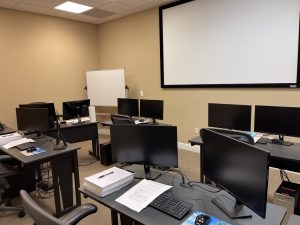
CLASSROOM EQUIPMENT – Students work on a dedicated Dell Client Desktop with 32GB memory with 512GB SSD drives – All Labs are executed the extremely fast Microsoft Data Center Hosted Lab Environment.
CAMPUS INTERNET – The campus is connected with a 1Gbps (1,000 Mbps) Verizon Fios Business Connection which provides complete internet (including VPN) access for students.
COMMON AREA – Amenities including snacks, drinks (Coffee, 100% juices, sodas, etc) all complimentary.
LODGING – We use the Hyatt Place Lakewood Ranch. This “upgraded” hotel offers extremely comfortable beds, great breakfast and very fast internet access.
NEAR BY AMENITIES – Many shops, restaurants and grocery options are available within walking distance. Additionally – the hotel provided scheduled shuttle services. Restaurants like Bone Fish Grill, Ruby Tuesday’s, Five Guys, Chipotle, Quiznos, Chili’s and over 20 additional choices in the immediate area. All of these options are offered in a pedestrian walking village.
Why Choose Us
CAREER CAMPS DIFFERENCE
Career Camps provides an in-depth hands on learning environment. Our instructors teach using demonstrations and explain concepts beyond the scope of the courseware. The best instructors are contracted from all across the US. These professionals are real world consultants who actually implement these technologies. Career Camps knows our clients work in the “real world” and it only makes sense to have an instructor with the experience in the real world.
Facilities – Many of our competitors over-crowd classrooms by placing 2 to 3 students per desk and 20+ students per instructor. Often these companies “extend” the life of very old equipment with slow performance on the software used today. Our average class size is 8 students. Our facilities have the best equipment with the most comfortable, focused environment for learning.
Instructors – Our CEO, Chester Flake holds one of the rarest Microsoft Certifications – the Microsoft Certified Learning Consultant (MCLC) Certification. This certification reflects a commitment to make sure our instructors are also actively engaged in real world consulting projects. Students expect a professional who can answer questions and demonstrate the technology.
Face to Face Training – We believe the best way to interact and learn is face to face training. Many of our competitors which offer local training are simply providing students with headphones/mic to attend class with an instructor at a remote location.
Test Pass – We offer a free retake voucher (if needed) for each of the exams required for certification. Any training center offering a “100% pass guarantee” would have to use unethical practices or unlimited test vouchers (which is not likely or practical).
Distractions – Students often look for a “local” training center so they can be close to home and work. Boot camp requires a tremendous time commitment during the program. Long class hours combined with self study each evening. The goal of boot camp is to achieve certification in a fraction of the time. We strongly recommend students attend camp away from home and work in a focused, distraction free environment.
Boot Camp – Boot camp is an accelerated training focused on teaching technology and testing students on the official exams. Most training providers “added” boot camps to the existing standard training classes they offer. These training centers think a boot camp is just a regular class where you send the student home with a voucher on the last day. Career Camps administers exams throughout the camp. Equally important – not every trainer can teach a boot camp and not all courseware is designed for boot camp format. Our trainers know the boot camp format and our courseware is designed for accelerated learning.
Florida – Career Camps has one of the most scenic locations boasting some of the best weather in US. We believe students should have a comfortable and inviting atmosphere while attending these otherwise intense programs. We place our location, facilities and amenities up against that any competitor.
You May Also Like:
Related products
-
MCA Microsoft Power Platform Developer Associate Certification Camp (1 Course, 1 Exam, 1 Cert)
$2,995.00 Select options This product has multiple variants. The options may be chosen on the product page -
MCA Microsoft Power BI Data Analyst Associate Certification Camp (2 Courses, 2 Exams, 2 Certs)
$3,995.00 Select options This product has multiple variants. The options may be chosen on the product page -
MCA Microsoft Azure AI Engineer Associate (w/ Azure AI Fundamentals) Certification Camp (2 Courses, 2 Exams, 2 Certs)
$3,995.00 Select options This product has multiple variants. The options may be chosen on the product page

